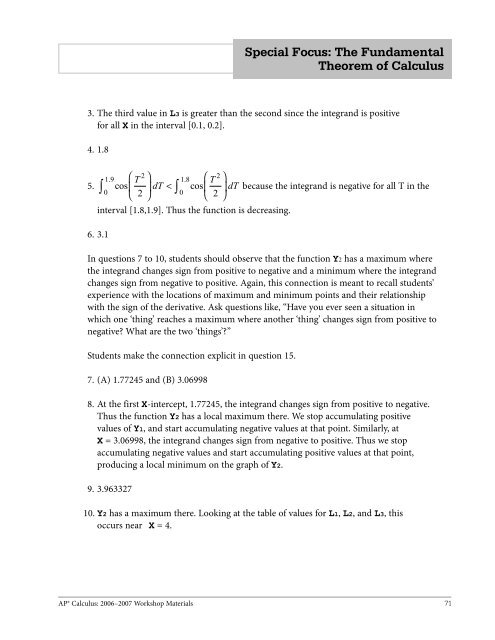AP Calculus
Calculus_SF_Theorem
Calculus_SF_Theorem
Create successful ePaper yourself
Turn your PDF publications into a flip-book with our unique Google optimized e-Paper software.
Special Focus: The Fundamental<br />
Theorem of <strong>Calculus</strong><br />
3. The third value in L3 is greater than the second since the integrand is positive<br />
for all X in the interval [0.1, 0.2].<br />
4. 1.8<br />
1<br />
5. . 9 ⎛ 2<br />
T ⎞ 1<br />
cos dT<br />
. 8 ⎛ T<br />
⎜ ⎟ < cos⎜<br />
0 2 0<br />
⎝ ⎠<br />
⎝ 2<br />
2<br />
⎞<br />
⎟ dT<br />
⎠<br />
∫ ∫ because the integrand is negative for all T in the<br />
interval [1.8,1.9]. Thus the function is decreasing.<br />
6. 3.1<br />
In questions 7 to 10, students should observe that the function Y2 has a maximum where<br />
the integrand changes sign from positive to negative and a minimum where the integrand<br />
changes sign from negative to positive. Again, this connection is meant to recall students’<br />
experience with the locations of maximum and minimum points and their relationship<br />
with the sign of the derivative. Ask questions like, “Have you ever seen a situation in<br />
which one ‘thing’ reaches a maximum where another ‘thing’ changes sign from positive to<br />
negative? What are the two ‘things’?”<br />
Students make the connection explicit in question 15.<br />
7. (A) 1.77245 and (B) 3.06998<br />
8. At the first X-intercept, 1.77245, the integrand changes sign from positive to negative.<br />
Thus the function Y2 has a local maximum there. We stop accumulating positive<br />
values of Y1, and start accumulating negative values at that point. Similarly, at<br />
X = 3.06998, the integrand changes sign from negative to positive. Thus we stop<br />
accumulating negative values and start accumulating positive values at that point,<br />
producing a local minimum on the graph of Y2.<br />
9. 3.963327<br />
10. Y2 has a maximum there. Looking at the table of values for L1, L2, and L3, this<br />
occurs near X = 4.<br />
<strong>AP</strong>® <strong>Calculus</strong>: 2006–2007 Workshop Materials 71


